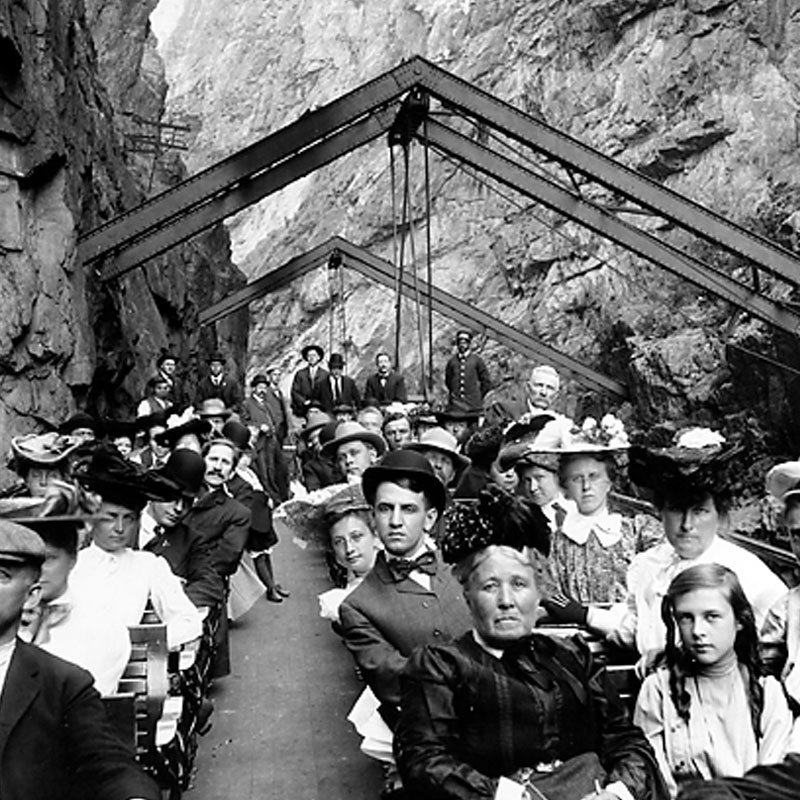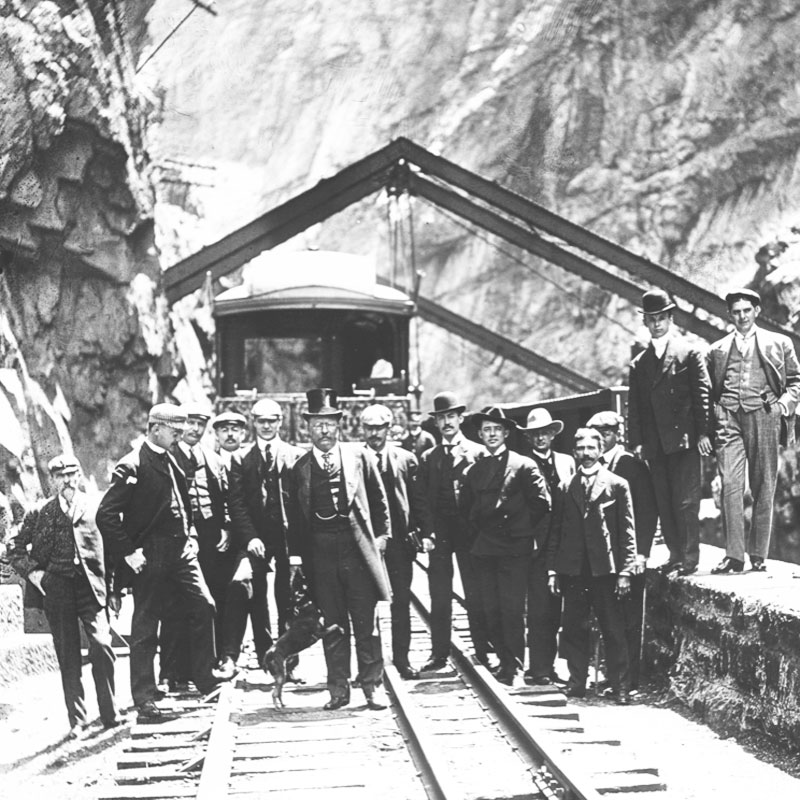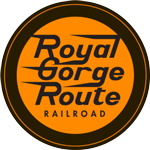A war between railroads
Royal Gorge History begins with silver! In the late 1870s miners descended on the upper Arkansas Valley of Colorado in search of carbonate ores rich in lead and silver. The feverish mining activity in what would become the Leadville district attracted the attention of the Denver & Rio Grande and the Santa Fe railroads, each already having tracks in the Arkansas valley. The Santa Fe was at Pueblo, and the D&RG near Canon City some 35 miles west. Leadville was over 100 miles away. For two railroads to occupy a river valley ordinarily was not a problem, but west of Canon City was an incredible obstacle – an obstacle that would result in a war between the railroads in the race to the new bonanza.

West of Canon City the Arkansas River cuts through a high plateau of igneous rocks forming a spectacular steep-walled gorge over a thousand feet deep. At its narrowest point shear walls on both sides plunge into the river creating an impassible barrier. On April 19, 1878, a hastily assembled construction crew from the Santa Fe began grading for a railroad just west of Canon City in the mouth of the gorge. The D&RG whose end of track was only ¾ of a mile from Canon City raced crews to the same area, but were blocked by the Santa Fe graders in the narrow canyon. By a few hours they had lost the first round in what became a two-year struggle between the two railroads that would be known as the Royal Gorge War.
The D&RG crews tried leapfrogging the Santa Fe grading crews, but were met with court injunctions from the Santa Fe in the contest for the right-of-way. The D&RG built several stone “forts” (such as Fort DeRemer at Texas Creek) upstream in an attempt to block the Santa Fe. Grading crews were harassed by rocks rolled down on them, tools thrown in the river and other acts of sabotage. Both sides hired armed guards for their crews. Rifles and pistols accompanied picks and shovels as tools. The railroads went to court with each trying to establish their primacy to the right of way. After a long legal battle that ended in the U.S. Supreme Court, on April 21, 1879, the D&RG was granted the primary right to build through the gorge that in places was wide enough at best for only one railroad.

The Santa Fe resorted to its larger corporate power and announced it would build tracks parallel to and in competition with the existing D&RG lines. The bondholders of the D&RG, fearing financial ruin from this threat, pressured the management of the D&RG to lease the existing railroad to the Santa Fe for a 30-year period. This created a short-lived truce in the struggle. The Santa Fe soon manipulated freight rates south of Denver to favor shippers from Kansas City (over its lines to the east) to the detriment of Denver merchants and traffic over the leased D&RG lines. During this period the Santa Fe constructed the railroad through the gorge itself. The D&RG, however, continued construction in areas west of the gorge still trying to block the Santa Fe.
After months of shrinking earnings from their leased railroad, the D&RG RGR management went to court to break the lease. An injunction from a local court restraining the Santa Fe from operating the D&RG on June 10, 1879, sparked an armed retaking of their railroad by D&RG crews – war in earnest in the old west. Trains were commandeered, depots and engine house put under siege, bullets flew and a few men died. A final peace in the war came after the intervention of the Federal courts, and the railroad “robber baron” Jay Gould who loaned the D&RG $400, 000 and announced the intention to complete a rail line in competition to the Santa Fe from St. Louis to Pueblo. On March 27, 1880, the two railroads signed what was called the “Treaty of Boston” which settles all litigation, and gave the D&RG back its railroad. The D&RG paid the Santa Fe $1.8 million for the railroad it had built in the gorge, the grading it had completed, materials on hand and interest. The Royal Gorge War was over. D&RG construction resumes, and rails reached Leadville on July 20, 1880.
Revolutionary Engineering
Hanging Bridge
An interesting part of the Santa Fe construction through the gorge is the hanging bridge at a point where the gorge narrows to 30 feet. Here the railroad had to be suspended over the river along the north side of the gorge as shear rock walls go right down into the river on both sides.
C. Shallor Smith, a Kansas engineer, designed a 175-ft plate girder suspended on one side by “A” frame girders spanning the river and anchored to the rock walls. The bridge cost $11,759 in 1879, a princely sum in those days. Although it has been strengthened over the years, this unique structure has served on a main rail line for over 118 years.

Passenger Service Ends Through the Royal Gorge
The Colorado Public Utilities Commission (PUC) granted the Rio Grande railroad authority to discontinue trains No. 1 and No. 2, the daily passenger trains between Denver and Salida, on July 28. This authority meant the last run of the two trains would be on July 27, 1967.
The first passenger train arrived at Salida in 1880. In 1882 the Royal Gorge route became a transcontinental rail link between Denver and Salt Lake. The first rails laid were “slim gauge,” 36″ between rails; later it was standard gauged to 4’81/2″ between rails to facilitate the movement of foreign line cars.

Taken from the Green Light Vol. 28, No. 5 Published monthly by the Denver & Rio Grande Western Railroad August, 1967. The Grand Canyon of the Arkansas River, known as the Royal Gorge, was one of the highlights on the route through the Rockies. The Denver & Rio Grande was then known as the Scenic Line of the World. When surveying parties first examined the route, it seemed impossible to construct a railway through the rugged canyon.
The perpendicular granite walls scarcely left room for the river. Blasting away the obstructions, a roadbed was constructed hugging the canyon walls. As the railway progressed, the rugged canyon walls grew higher and higher, the river became a raging torrent to the sea, and areas the sun could not penetrate. At the narrowest point, which is 30 feet wide, a long, iron bridge was suspended from the smooth canyon walls. This became the famed hanging bridge. Passenger trains have stopped at this point for decades to allow passenger to alight and marvel at the sights and sounds of nature and see how man had conquered one of nature’s obstacles. The walls of the canyon at this point rise 2,600 feet above the track.
During the 1890’s, four transcontinental passenger trains a day passed through the Royal Gorge. The original route between Denver and Salt Lake went over Marshall Pass, through Gunnison, Montrose, and Grand Junction. Later, the main line was constructed over Tennessee Pass through Glenwood Springs and into Grand Junction. With the opening of the Moffat Tunnel in 1928, passengers could go either way to Salt Lake. If they chose the Royal Gorge route, they would leave early in the morning arriving at Grand Junction in time for their train to be combined with the overnight Prospector for the run into Salt Lake. Planes, with their faster schedules, automobiles, for the independent traveler, and buses, were the downfall of the Royal Gorge, as passengers took to other forms of transportation.
The last segment of this famous train was between Denver and Salida. April 1 was the crowning blow, when the U.S. Post Office Department cancelled the mail contract on this train, leaving the Rio Grande with empty head-end cars and coaches.
The handwriting was on the wall. Authority was soon forthcoming for discontinuance of the Royal Gorge trains No. 1 and No.2. On July 26, 1967, 56 passengers and 34 Head Start children boarded train No. 1 at Denver. The children, many having their first train ride, detrained at Littleton. Passengers boarded the train at every station along the way that day.
Arriving at Cañon City, 104 passengers got on the train for the ride through the Royal Gorge, getting off at Parkdale, the first stop beyond the hanging bridge. Over 300 passengers had ridden the train the day before it was to be discontinued. Arrival at Salida saw 171 passengers still on board. To many at the depot, the alighting mass brought back memories of days of long ago. For the final run of No.2 out of Salida, 120 persons found their seats in the three coaches.
The trip was uneventful except for the feeling of nostalgia that prevailed at a time like this. Each one on the train knew they were part of Rio Grande history, being made on the last trip through the Gorge from the west.
Est.1998
BEGINNING AGAIN
A premier destination
In 1996 the Union Pacific Railroad (UP) acquired control of the Southern Pacific railroad which itself had acquired control of the Denver &Rio Grande Western Railroad (D&RGW) in the early 1980s. As part of the rail lines that UP inherited was the line from Pueblo, CO to Dotsero, CO which was part of the original D&RGW mainline constructed in the 1870s and 80s. The UP decided that portions of this track of some 221 miles were no longer needed in its operations. Of this excess trackage the portion between Canon City and Sage (just east of Gypsum), some 160 miles, would be abandoned and converted to a trail (Rails to Trails).

Colorado Governor, Roy Romer, told the UP that the state would not oppose the abandonment provided that the 12 miles from Canon City to Parkdale would be left intact. (At the time, Parkdale was just a 9,200 ft CTC controlled passing track on the railroad, there was no industrial or commercial activity. There were the foundations of a long, dismantled feldspar processing plant). Romer wanted the line through the Royal Gorge to be available as a means for tourists to see this magnificent natural gorge from the river level. To this end agreement was reached.
The state developed a bidding process that would hopefully result in the selection of a private operator that could construct a suitable passenger train operation through the gorge. Bidding solicitations were advertised and bid packages (at $500) sent to respondents. The operators of the Georgetown Loop Railroad (the Loop) did not ask for a bid package. This company became involved when Mr. Dan Quiet (one of the bidders) inquired about our joining his efforts to gain the right to operate a Train through the gorge. Mr. Quiet was also involved with two other men, Bill Fehr, and Mitch Albert, who intended to develop a rock quarry at the end of the 12 miles at Parkdale. There was a large gravel deposit there and they wanted to transport it by rail to markets.
An agreement was reached that a company called Royal Gorge Express (RGX): consisting of, 50% on one part, of Mr. Quiet and the Loop company as the passenger side of the company and, 50% the other part with Mr. Fehr and Mr. Albert as the freight haulers would submit a bid. These two entities would be Canon City & Royal Gorge Railroad and Rock & Rail respectively. Six bids were submitted, and RGX was selected for the right to purchase the 11.92 miles of the line (MP 160 to MP171.92), including the track, bridges and other improvements from the UP. On July 6, 1998 the line sale was finalized.
The success of RGX in being selected rests on its thorough, detailed presentation, and also with the Loop company being involved in any future train operation. The Georgetown Loop had been in operation for 25 years at that point and had a credible record of competence and experience in developing and operating a scenic railroad. As none of the other participants in RGX had any such credentials, the reputation of the Loop as a successful scenic railroad operator had to have had a significant effect in the State’s decision to select RGX as the company most likely to successfully operate the line. After 23 years of stable growth and safe train operation the State’s decision was well justified. The Royal Gorge train has become a significant attraction and has greatly benefited the economy of Canon City and Fremont County.
Royal Gorge History reaches the modern-day with The Royal Gorge Route Railroad being reestablished in the fall of 1998 and has become a premier destination attraction carrying more than 200,000 guests through the Royal Gorge each year. Our vision is to provide a quality experience, combining the spectacular scenery of the Royal Gorge, the nostalgia of 1950’s train travel, with unique dining options and exceptional service. The Royal Gorge Route has been instrumental in preserving this breathtaking canyon and ensuring a vital part of Colorado history will be passed along to the next generation.
Why do so many people ride the train? We are not a theme park or carnival experience. We do not offer thrill rides, but instead have grown as a major destination attraction through ensuring the Royal Gorge remains a special place and should be preserved much like any one of our National Parks. We believe riding the rails through the Royal Gorge and spotting Big Horn Sheep, Blue Heron, Bald Eagles, and enjoying the tumbling Arkansas River with your family or special someone is a very unique experience. The train provides the means to unwind, enjoy family time and Mother Nature up close.
When we began operating trains through the Royal Gorge, we had five coach cars and one class of service. Our dream was to introduce levels of service not seen in the rail industry. We were met with much pessimism as many thought attracting travelers both from the international and national markets to the Royal Gorge region who would enjoy a high quality culinary experience impossible. Now, after 11 years we find other rail lines attempting to copy our “recipe for success.”
We pride ourselves on exceptional guest service and purchase only the highest quality food items available. We constantly work to ensure our guest’s expectations are met and exceeded. We have our challenges and have grown through valuable input from our staff and guests. We invite you to experience the Royal Gorge Route Railroad and look forward to having you on board.
Testimonials
Adventure awaits
Hop aboard the Royal Gorge Route Railroad and experience a one-of-a-kind adventure through the Royal Gorge and Colorado Rockies. Departing daily from the Santa Fe Depot in Canon City.







